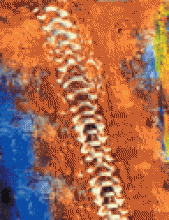Rehabilitation medicine series

Figure. Photo by: Fred Sebastian
A 3-part series on rehabilitation medicine begins in this issue of CMAJ. The series will cover 3 distinct clinical problems within this broad specialty: autonomic dysreflexia, dysphagia and spasticity. Maximizing independence in patients with physical disabilities will be the series' unifying theme.
In the first part of the series, Blackmer reviews the syndrome of autonomic dysreflexia. Usually occurring in patients with a spinal cord injury above the sixth thoracic vertebra, this syndrome is characterized by episodes of uncontrolled sympathetic output. Despite injury to the cord, preserved spinal reflexes mediate this response, which can result from any noxious stimuli below the level of the cord injury. Both pharmacologic and nonpharmacologic treatments for the syndrome are outlined.
The nature and severity of physical harm in child abuse

Figure. Photo by: Tennyson Center for Children
Although physicians understand child abuse to be an important health and social problem, its epidemiology is poorly understood. Trocmé and colleagues present data from the Canadian Incidence Study of Reported Child Abuse and Neglect. They found that, among more than 60 000 substantiated cases of child abuse, 13% involved moderate injuries or health conditions, and 4% involved injuries or health concerns that were severe enough to require medical attention. The present mechanism for dealing with child abuse is predicated on the need for rapid intervention to ensure adequate protection of the child. However, because 96% of the cases did not involve serious physical harm, the authors suggest a need to consider a shift in priorities from rapid interventions to longer-term service needs.
In a related commentary, Ward and Bennett caution that the results of this study should not reassure physicians. They point out that the physical signs of abuse are often not obvious and that the emotional trauma that accompanies abuse goes beyond the 4% of children with severe injury or health conditions cited in the above study.
Treating acute myocardial infarction

Figure.
No one disputes that the primary goal in the treatment of acute myocardial infarction is timely reperfusion of the infarct-related artery. However, the question of whether fibrinolysis or angioplasty is superior in achieving this outcome is the subject of intense research. In a commentary, Armstrong and Welsh caution against unbridled enthusiasm for mechanical reperfusion and raise important concerns regarding its wholesale use. Specifically, they point out that the evidence for its advantage over fibrinolysis in all situations has not been shown and that significant resource questions must be answered before timely round-the-clock angioplasty is considered the standard of care.
Long-term outcomes after MI also depend greatly on the care patients receive after they leave hospital. Young and colleagues show that inner-city patients who were followed by a community-based disease management program experienced better outcomes than those who received standard care: lower rates of admission for angina and congestive heart failure, and fewer emergency department visits.
Management of dyslipidemia
Genest and colleagues have updated the recommendations for the management of dyslipidemia first published in 2000 (CMAJ 2000;162:1441-7). The guidelines have been simplified, reflecting a modification in the risk equations used for cardiovascular disease. Also included is an assessment of factors that influence the risk of cardiovascular disease: apolipoprotein B, lipoprotein(a), homocysteine and high-sensitivity C-reactive protein. A summary of the recommendations is presented; the full set of guidelines is available at www.cmaj.ca.
See page 921











